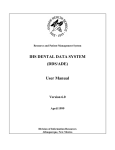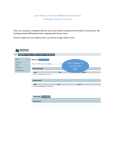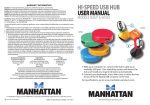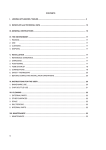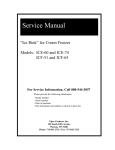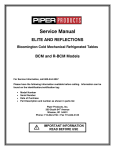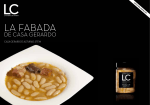Download Food Talk Spring 08
Transcript
SANITATION TIPS FOR FOOD WORKERS Spring 2013 Does that Microwave Oven Have a ‘Food Safety’ Button? Also in this issue… Introducing a messy eater Page 2 How to clean the microwave Microwave ovens these days come with fancy sensors and preprogrammed settings. But—for now, at any rate—they don’t include a “Food Safety” button. So you can’t rely on them to tell you when the heated food is safe to eat. Microwaves are programmed to cook food “on average,” but they can’t cope with all the variations of individual dishes. Think about this. What happens if you place two pot pies in the microwave at the same time, and then cook them for the time recommended on the packaging for one pie? They will not be cooked to a safe temperature and they could make your customers very ill if they contain dangerous bacteria such as Salmonella or Listeria. To cook food safely in a microwave, it helps to know how the oven works. They use electromagnetic waves to excite the molecules in water, fats and oils. This produces friction that generates heat that cooks the food. If one section of a food — say part of a chicken pot pie — contains more moisture than another, the moist section will heat more quickly. That’s why, after you heat food in a microwave, you may see the instruction, “Let Food Stand Covered” for several minutes. This allows time for the heat to reach all parts of the food. That chicken pot pie, for example, needs to reach 165 degrees F (74 degrees C) throughout, to kill any Salmonella or other pathogens. Page 2 “Testimonials” tell stories of foodborne illness Page 3 When in doubt...about mold Page 3 Test yourself on food safety Page 4 Copyright 2013 Setanta Publishing, LLC www.foodtalk.com Letting food stand covered for several minutes helps complete the cooking. Also, microwaves only penetrate the food to a depth of about one and a half inches. In thicker pieces of food or soups, they don’t easily reach the center, so turning over or stirring the food helps, along with letting it stand covered to complete the cooking process. Links to Illness Ever since the widespread use of microwave cooking began in the late 1960s, there have been reports of foodborne illnesses linked to foods prepared in microwave ovens. Microwaved turkey franks have been linked to Listeria. Microwaved fish have been found to contain live Anisakis worms. Microwaved pork sausage has included live Trichina parasites, and microwaved frozen entrees have contained Salmonella—that pot pie again. FOOD TALK Besides leaving “cold spots” in some foods, another problem with microwave ovens is that some are more powerful than others. That’s why you will see different microwave cooking instructions on food labels, with shorter cook times recommended for high-powered equipment (1,000 watts or more) or longer cook times for lower-power equipment. Also, microwave ovens tend to become less efficient over time, so it takes longer to cook that chicken pot pie safely than it did when the equipment was new. If you don’t know the wattage of a microwave oven in your establishment, look on the inside of the oven’s door or on the serial number plate on the back of the oven. Use Approved Containers Only use cookware that is approved for use in the microwave oven. Glass, ceramic containers, and some plastics that are safe to use are usually labeled for microwave oven use. It is safe to use oven cooking bags, straw and wood baskets, most paper plates, towels, napkins and bags. And It is safe to use wax paper, parchment paper, and heavy plastic wrap. But don’t allow the wrap to touch the food and vent it to allow steam to escape. Finally, because of the many variations in microwave oven equipment, including mixed ovens that include convection or steaming, it is always best to use a thermometer. Introducing a Messy Eater Did you know that flies don’t actually eat solid food — they only consume liquids? And their table manners are like something from a horror movie. Say one lands on your dinner. The first thing it does is spit some intestinal juices onto the food to make it a liquid and then it consumes the liquid through its proboscis – a sucking tube at the bottom of its face. The fly leaves behind a sample of whatever bacteria it may have picked up from manure or whatever it was feeding on or that stuck to its hairy legs before it walked on your plate. Flies feed on sewage, garbage, manure and human feces before they enter your kitchen. They carry all sorts of disease-causing organisms, including Salmonella and dangerous strains of E. coli. For every one fly you see in your kitchen, there are an estimated 19 that you don’t see. Female flies lay about 100-125 eggs at a time, and SPRING 2013 Cleaning the Microwave Cooking food safely in a microwave involves keeping the equipment clean. You will find specific instructions in the user’s manual for doing this, but the U.S. Department of Agriculture offers the following advice for effective cleaning: • Remove spatters and spills as they occur so food residue won’t become dried on. • Wipe with a soft cloth or clean paper towel dampened with warm water. • For heavier soil, use baking soda, a mild soap, or dishwashing liquid. • Do not use steel wool, scouring pads, abrasive cleaners, or oven cleaners. Try this tip for removing food odors or to loosen baked-on food residue: Mix six tablespoons of baking soda or 1/2 cup of lemon juice with one cup of water in a microwave-safe glass measure. Microwave the mixture until it boils. Then leave the mixture in the microwave without opening the door until the mixture cools. The steam will help loosen food residue and remove odors. Afterwards, you can wipe the surfaces with a soft cloth or paper towel. they can hatch in just eight hours. As we enter the warmer months of the year, flies can become a serious problem in a foodservice operation. And it is not a good idea to rely on the pest control company to deal with insects and other pests. In fact, it’s the food facility manager’s responsibility to see the problem and then work with the pest professional to fix it. Here are some ways to prevent infestation with flies or other pests: • Inspect incoming shipments of food and supplies for evidence of insects and rodents; • Regularly inspect the premises, using a flashlight to look under equipment and in corners for evidence of infestation; • Have your pest control operator catch or kill any Marathon County Health Department Food Safety Class Resources “Food Safety 4U”: Instructor is Mary L. Myszka, RS. Call 715-432-7432 or 715845-2496 to register. State Certification and Recertification Classes held at Great Dane Pub, Wausau. School Foodservice & independent classes on Food Safety are available, location flexible. Northcentral Technical College: Call 715-675-3331, Ext.5861or 888-NTC7144, Ext. 5861 to register or online at www.ntc.edu/wis/register. Courses include State Certification, Recertification, Employee, and School Food Service, ITV locations available. WI Restaurant Association: www.wirestaurant.org or call 1-800-5893211 to register. State Certification & Recertification. Locations vary in the state. Tavern League of WI, Attn: Cindy Roehl: www.tlw.org or call 1-800-4459221 to register. State Certification & Recertification. Locations vary in the state. WE’VE MOVED The Health Department has moved. Our new address is: 1000 Lake View Drive, Ste 100 Wausau, WI 54403-6786 Spring 2013 Issue 64 New Environmental Health Sanitarian Introducing: Heidi Ward Hello, my name is Heidi Ward. Last year in April, the Marathon County Health Department hired me as an Environmental Health Sanitarian, following the retirement of Kristal Knapp. It has been just over a year since I started and I have been able to visit most of the facilities assigned to me. As a requirement for this position, I need to obtain the Registered Sanitarian/Registered Environmental Health Specialist License. Currently, I am studying for that license exam which I hope to take this upcoming summer. Before starting this job, I lived in Eau Claire, Wisconsin, where I attended the University of Wisconsin-Eau Claire. In December of 2011 I graduated with a Bachelor of Science Degree in Environmental Public Health, which happens to be the same program Jackie Bethel graduated from in 1979! While in college, I completed my practicum in the summer of 2011 with the La Crosse County Health Department as an Environmental Health Limited Term Employee. During my employment with La Crosse County, I collected water samples from beaches and pools, tested pool water, and conducted food, pool and lodging inspections under the supervision of other Registered Sanitarians. Originally, I grew up on a small dairy farm in Central Wisconsin where my family raised cows, pigs, and chickens. In addition to the animals, my family always planted a large vegetable garden, picked and preserved various types of berries, and made maple syrup. Growing up in this type of lifestyle fostered my interest of the environment and passion for helping others. I look forward to continue working to make Marathon County a safe place to live. Bigger, Better Bad Bug Book If you want to learn more about the foodborne pathogens you read about herein Food Talk, you can take a look at the Bad Bug Book. The Food and Drug Administration has just issued a new edition of this excellent resource, which gives lots of information about the pathogens and toxins that cause foodborne illness. Each chapter in the new edition includes a section written in everyday language for non-scientists, with a focus on food safety and tips for how to reduce the risk of illness. One section identifies the food sources and the nature of the foodborne illnesses caused by each pathogen or toxin. The new edition also includes a section on each bad bug’s characteristics and the factors that affect its survival. The handbook includes information about foodborne bacteria, viruses, parasites, prions, and naturally occurring toxins. It is easy to find and read online. Just visit www.fda.gov and search for the “Bad Bug Book 2nd Edition.” (Reprinted with permission from Food Talk, Spring 2012) Food Thoughts Pg 2 Issue 64 Spotlight on: Weston Health Club & Brews Brothers Pub Two local businesses whose grand-opening plans were put on hold when a December fire burned their original location to the ground have found a new home and are finally open and doing business. Business partners Steve Day and Gary Hanson opened the Weston Health Club and Brews Brothers Pub on Barbican Avenue in Weston, next to River Valley Bank and near the Highway 29-Highway X interchange. Weston Health Club is a new experience featuring full-service locker rooms and complimentary towel service included with memberships. Specialized programs are offered which include: Personal Training Programs and Corporate Memberships/Wellness. Check out the selections at the smoothie/coffee bar or the full line of supplements. What to Do If a Customer Becomes Ill It’s a routine day in your foodservice establishment, but then someone calls to complain that he got sick from something he ate there. One of your waiters has symptoms of foodborne illness, including nausea, vomiting, fever and cramps. He thinks it’s something he ate. What should you do? Here’s what: • If you suspect a particular food, stop serving it. • Call the health department. • Save the suspect food. The quicker you act to protect your customers, the less damage will be done to your business by a foodborne outbreak. Food poisonings don’t normally go away. They often get worse until you find the cause. Don’t Throw it Away If you think a particular food may be the problem, stop serving it immediately. But don’t throw it away. Put it in the refrigerator so the health department can test it in the laboratory. But label it carefully to make sure no one uses the food. If it turns out to be contaminated, the data will help in locating the problem. If it isn’t contaminated, you’ll be off the hook. Either way, it helps you to have the food sampled. Report the incident to the health department right away. The department will work with you to find and solve the problem and to prevent it from happening again. Contact the owner immediately or headquarters if you are part of a chain. They have a right to know and can help you in making the decisions that will have to be made. (Reprinted with permission from Food Talk Summer 2012.) FOOD THOUGHTS - Published Spring 2013 By: Marathon County Health Department ~ 1000 Lake View Drive, Ste 100 Editor: Keith Baine ~ Layout: Bonita Buchberger ~ Wausau, WI 54403 SPRING 2013 What Foodborne Illness Does to Families The Food and Drug Administration has created three short video “testimonials’ that describe the affects of severe foodborne illness on two families. One testimonial is by Bernadette Jacobs of Goodrich, Mich., who became infected with Listeria monocytogenes after eating a sandwich from a sandwich shop when she was 32 weeks pregnant. Both Bernadette and her baby, Kate, who was delivered by means of an emergency c-section, had bacterial meningitis, a potentially deadly complication of listeriosis infection. Kate also developed hydrocephalus, or “water on the brain.” Both survived, but they will be dealing with the affects of their illnesses for years. The other two videos tell the stories of Zella Ploghoft of Athens, Ohio, and her family. Both she and her son developed salmonellosis after eating in a local restaurant. pests you find. One way to help them is to mark the place where insects or rodents are seen on a plan of the establishment. • Eliminate conditions that favor the pests. Remove food debris, garbage and odors that may attract pests to an area. Clean countertops, wipe up spills, sanitize equipment, flush drains and wash garbage bins, to discourage pests. • Caulk, screen, or plug up holes around pipes or doors, or hang curtains to help keep pests out. • Because of the hazards involved, pest control chemicals should only be applied by a trained technician. When in Doubt…About Mold You have probably heard the rule of thumb “When in Doubt, throw it out.” Sometimes it can be hard to tell if food is spoiled. But if you see signs of mold, such as slimy, rotten or strangely colored growths on the surfaces of food, don’t FOOD TALK Mrs. Ploghoft suffered terribly and survived for seven weeks in the hospital before she died. Her son recovered after several days of severe illness. The same outbreak resulted in 56 illnesses, seven hospitalizations and one death. “Part of the frustration with food poisoning is that you know it didn’t have to happen,” says Zella’s husband, Milton. Each video ends with the following advice for food workers about how to protect customers and prevent foodborne illness: - Wash your hands and food contact surfaces often. • Do not work when you are sick. • Do not touch ready-to-eat food with your bare hands. • Separate raw meats from other foods. • Cook food to the correct temperature. • Cook food promptly. • Maintain food at the proper temperature and for the proper time. Links to the three videos are available on FDA’s website www.fda.gov/foodemployeetraining. take a chance. Some molds, such as those used in making cheeses, are helpful, but others can produce a poisonous by-product called mycotoxins. Some moldy foods can be salvaged, if the food is hard or firm, like a chunk of cheddar cheese. But do you want to take the chance that you have removed all the mold? If the food is soft, such as bread or a soft cheese, you should throw it away. And if you are not sure what to do…just remember the rule of thumb! Prevent Foodborne Illness! Wash Your Hands! FOOD TALK SPRING 2013 Test Yourself on Food Safety Try this quick quiz to check what you have learned in this issue about microwave ovens, flies and molds. 1. Foods cooked in microwave ovens sometimes cause illness because: a. Microwave sensors don’t work. b. Microwave ovens can leave “cold spots” in foods. c. Users cook the food without following the instructions on the package. d. All of the above. 2. The wattage of a microwave oven can usually be checked by looking: a. On the packaging the equipment came in. b. On the inside of the oven door or the serial number plate on the back. c. On the internet. b. Chewing. c. Spitting on it with their intestinal juices and then sucking up the liquid. d. None of the Above. 4. To prevent infestation with flies or other pests, it is important to: a. Inspect all incoming food, to check for flies and other pests. b. Check for pests under equipment and in dark corners using a flashlight. c. Plug up any holes that could allow pests to enter. d. All of the Above. 5. Signs of mold on food include: a. Tiny bubbles. b. Very small eggs. c. Unusual colors. d. All of the Above. d. All of the above. Answers: 1(d), 2(b), 3(c), 4 (d), 5(c) 3. Flies have bad table manners and they consume food by: a. Picking it up first with their front legs. Sources for this issue: U.S. Department of Agriculture (www.fsis.usda.gov/factsheets), Food and Drug Administration (www.fda.gov/foodemployeetraining).










